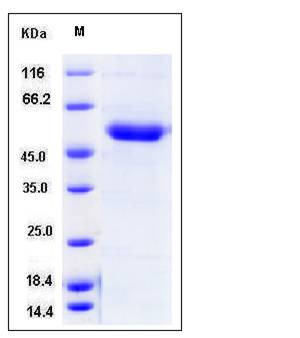Mouse CD39 / ENTPD1 Protein (His Tag)
2610206B08Rik,AA408691,Cd39,NTPDase-1
- 100ug (NPP3231) Please inquiry
| Catalog Number | P50398-M08B |
|---|---|
| Organism Species | Mouse |
| Host | Baculovirus-Insect Cells |
| Synonyms | 2610206B08Rik,AA408691,Cd39,NTPDase-1 |
| Molecular Weight | The secreted recombinant mouse ENTPD1 consists of 451 amino acids and has a calculated molecular mass of 51 kDa. The recombinant protein migrates as an approximately 105 kDa band in SDS-PAGE under reducing conditions. |
| predicted N | Thr 38 |
| SDS-PAGE |  |
| Purity | > 97 % as determined by SDS-PAGE |
| Protein Construction | A DNA sequence encoding the mouse ENTPD1 (P55772) extracellular domain (Thr 38-Ile 478) was fused with a polyhistidine tag at the C-terminus and a signal peptide at the N-terminus. |
| Bio-activity | Measured by its ability to hydrolyze the 5’phosphategroups from the substrate adenosine 5’triphosphate(ATP). The specific activity is > 25,000 pmoles/min/μg. |
| Research Area | Immunology |Cluster of Differentiation (CD) |T Cell CD Antigen |
| Formulation | Lyophilized from sterile 20mM Tris, 500mM NaCl, pH 7.4, 10% gly 1. Normally 5 % - 8 % trehalose, mannitol and 0.01% Tween80 are added as protectants before lyophilization. Specific concentrations are included in the hardcopy of COA. |
| Background | CD39, also known as ENTPD1, belongs to the GDA1/CD39 NTPase family. It is expressed primarily on activated lymphoid cells and can also be detected in endothelial tissues. The vascular isoform and the placental isoform II are present in both placenta and umbilical vein, whereas placental isoform I is present in placenta only. CD39 can hydrolyze both nucleoside triphosphates and diphosphates. It is the dominant ecto nucleotidase of vascular and placental trophoblastic tissues and appears to modulate the functional expression of type 2 purinergic (P2) G protein coupled receptors (GPCRs). CD39 transgenic mice exhibit impaired platelet aggregation, prolonged bleeding times, and resistance to systemic thromboembolism. There is a correlation between ATP hydrolysis and triglycerides in patients with chronic heart disease, suggesting a relationship between ATP diphosphohydrolase and thrombogenesis. In the nervous system, CD39 could hydrolyze ATP and other nucleotides to regulate purinergic neurotransmission. |
| Reference |
